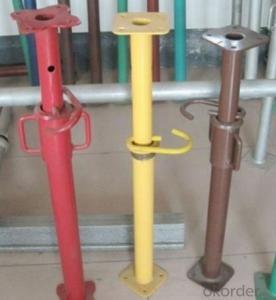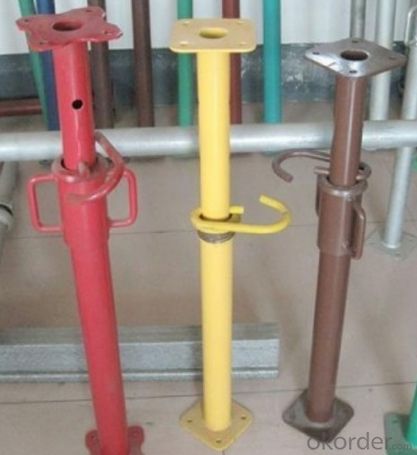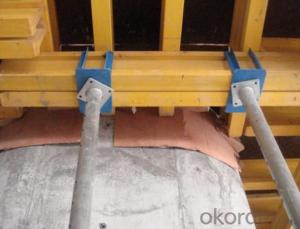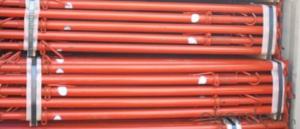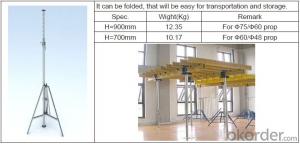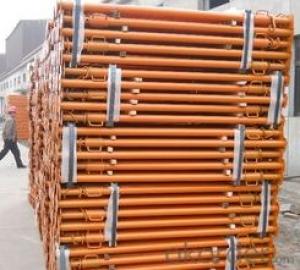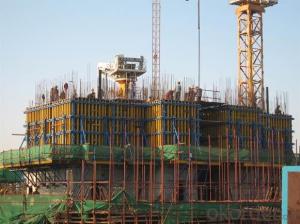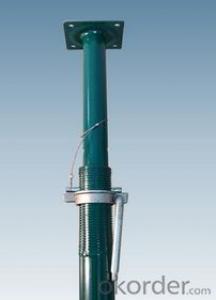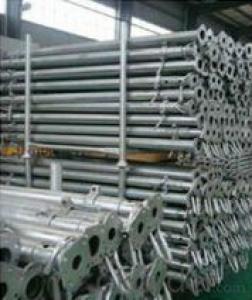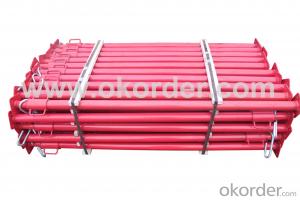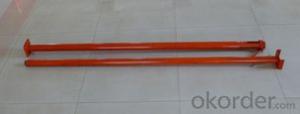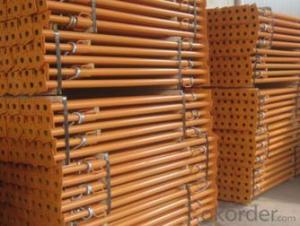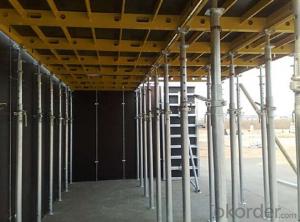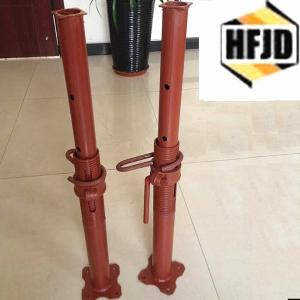The Doka formwork accessories-- steel prop GM-57
- Loading Port:
- Tianjin
- Payment Terms:
- TT OR LC
- Min Order Qty:
- 10000 PCS
- Supply Capability:
- 10000 PCS/month
OKorder Service Pledge
OKorder Financial Service
You Might Also Like
Quick Details
| Model Number: | SXV-GM-57 | ||||
| Size: | 15-17mm/as your demands | Material: | Q195/Q235/etc | Certificate: | ISO 9001:2008/CE/TUV |
| Surface: | Hot-dip galvanization/ electro galvanization /or as your request | Standard: | EN74,BS1139,JIS,ISO9001:2008 | Weight: | 5000kg,0.4-0.6kg/pcs or as your demands |
| Use: | suit for PERI/DOKA/MEVA/etc | Type of Mould: | steel mould; aluminum mould | Mould Quantity: | more than 10 sets |
Packaging & Delivery
| Packaging Detail: | in steel plate or plywood plate, or as your request |
| Delivery Detail: | 15-30 days after confirmation |
Specifications
formwork parts
1.Material:Q195/Q235/etc,
2.Standard:EN74,BS1139,JIS,ISO9001:2008
3.OEM service
The Doka formwork accessories-- steel prop GM-57
Name: The formwork parts -- SXV-GM-057;
Produce Equipment: 350kg and 500kg inter- Medium Frequency melting Furnace--two pieces of each;
Produce Technology: sodium silicate precision casting; silica sol precision casting;pressing;
Produce Capacity: 100 tons/month
Mould: aluminum mold and steel mould, 6 sets of each;
Output: 3000 pcs/day
Item | formwork accessories |
Material | Q195/Q235/etc |
Dimensions | Φ 20-40/L=155-200;Φ25/L=200;as your demands |
Surface | Hot-dip galvanization/ electro galvanization /painted/or as your request |
Standard | EN74,BS1139,JIS,ISO9001:2008 |
Note | OEM service is available |
MOQ | 1000pieces |
Package | in steel plate or plywood plate, or as your request |
Payment Terms | TT,L/C, we can contact in detail |
Delivery Time | 20-30days |
- Q: Can steel props be used in the installation of temporary fire protection systems?
- Yes, steel props can be used in the installation of temporary fire protection systems.
- Q: What are the potential aesthetic considerations when using steel props?
- When using steel props, potential aesthetic considerations include the visual appearance of the props themselves, their compatibility with the surrounding environment or design, and the overall impact they may have on the aesthetic appeal of the space. Additionally, the choice of finishes, colors, or textures of the steel props can also play a role in their overall aesthetic integration.
- Q: What is the installation spacing of the steel support of the tunnel 50mm
- According to the specification, installation of +5, -5, but the general requirements not only go online, now some requirements to a total of zero error, that is in accordance with the design of steel arch control quantity, to the final detection according to the length calculation of steel arch number
- Q: Are steel props adjustable for supporting curved structures?
- Steel props, also called acrow props or adjustable steel props, have the capability to support curved structures. They consist of two main parts: an outer tube and an inner tube. By adjusting the height and securing it with a pin or screw mechanism, these props can be customized to fit the specific shape and curvature of a structure. Made from strong and durable materials like steel, these props are capable of bearing the weight and load of curved structures. Consequently, they are an excellent option for offering adjustable support during construction, renovation, or any other situation that necessitates temporary support for curved structures.
- Q: What are the common applications of steel props?
- Steel props, also known as adjustable steel props or steel shore props, are widely used in construction and building projects. These props provide temporary support to various structures during construction or renovation. Here are some common applications of steel props: 1. Formwork Support: Steel props are extensively used to support formwork structures during the casting of concrete. They provide stability and load-bearing capacity, ensuring the formwork stays in place until the concrete sets. 2. Slab and Beam Support: Steel props are commonly employed to support slabs and beams during construction. They help distribute the load evenly, preventing any potential sagging or collapsing of the structure. 3. Shoring and Scaffolding: Steel props are an essential component of shoring systems used to stabilize and support excavations, trenches, and walls. They help prevent soil movement and maintain structural integrity during earthworks and foundation construction. 4. Temporary Supports: Steel props are utilized as temporary supports when removing load-bearing walls, columns, or beams during renovation or alterations. They provide a secure and adjustable solution to ensure the remaining structure remains stable while the modifications take place. 5. Temporary Roof Supports: Steel props are commonly used to provide temporary support to roofs during repairs or construction. They help maintain the structural stability of the building, especially in cases where the existing roof structure has been compromised. 6. Mezzanine and Raised Floor Support: Steel props are employed to support mezzanine floors and raised platforms, providing stability and load-bearing capacity. They help distribute the weight of the floor and any additional loads to the foundation or lower level. 7. Pipe and Duct Support: Steel props are used to support pipes, ducts, and other utilities during installation or maintenance. They prevent sagging or movement of these systems, ensuring they are properly aligned and supported. In summary, steel props find wide-ranging applications in construction projects, including formwork support, slab and beam support, shoring and scaffolding, temporary supports, temporary roof support, mezzanine and raised floor support, and pipe and duct support. Their adjustable nature, load-bearing capacity, and versatility make them a reliable choice for providing temporary support during various construction activities.
- Q: What are the safety precautions to consider when working with steel props?
- To guarantee a safe working environment while working with steel props, it is essential to consider several safety precautions. 1. Adequate training and instruction: Ensure that workers receive proper training and instruction on the correct usage of steel props. This entails understanding the guidelines provided by the manufacturer, load capacities, and installation procedures. 2. Pre-use inspection: Before utilizing steel props, carefully examine them for any indications of damage or wear. This includes checking for cracks, bends, or corrosion. If any defects are detected, refrain from using the props and replace or repair them. 3. Utilize appropriate personal protective equipment (PPE): Workers must always wear the necessary PPE when dealing with steel props. This may comprise safety glasses, gloves, hard hats, and protective footwear. 4. Secure the props effectively: Properly fasten or anchor steel props to prevent shifting or collapsing during use. This may involve employing pins, bolts, or other suitable fasteners. 5. Ensure proper loading and weight distribution: When utilizing steel props to support loads, it is crucial to evenly distribute the weight within the recommended load capacity. Overloading steel props can result in failure, leading to potential accidents or injuries. 6. Minimize movement and impact: Avoid subjecting steel props to excessive movement or impact, as this can weaken their structural integrity. Exercise caution while handling and positioning the props to prevent unnecessary stress or damage. 7. Regular maintenance and inspection: Regularly inspect and maintain steel props to ensure their safety and functionality. This includes cleaning, lubricating, and checking for any signs of wear or damage. By adhering to these safety precautions, workers can minimize the risk of accidents or injuries when working with steel props. Prioritizing safety and following proper procedures is crucial in establishing a secure working environment.
- Q: Are steel props suitable for supporting temporary manufacturing facilities?
- Yes, steel props are suitable for supporting temporary manufacturing facilities. Steel props, also known as adjustable steel props or acrow props, are commonly used in construction and temporary structures to provide support and stability. They are typically made of high-quality steel and are designed to withstand heavy loads and provide a secure foundation. Steel props offer several advantages that make them suitable for supporting temporary manufacturing facilities. Firstly, they are adjustable in height, allowing for flexibility in supporting structures of different sizes and heights. This adjustability feature makes them versatile and adaptable to various manufacturing facility requirements. Moreover, steel props are highly durable and can withstand the demanding conditions of a manufacturing environment. They are designed to provide structural support and stability, ensuring the safety of the temporary facility and the workers within it. Steel props are often tested and certified to meet industry standards, guaranteeing their reliability and safety. Additionally, steel props are relatively easy to install and dismantle, making them ideal for temporary structures. They can be quickly set up and adjusted as needed, allowing for efficient and cost-effective construction of temporary manufacturing facilities. Their lightweight nature also makes them easy to transport and maneuver, further adding to their suitability for temporary structures. In conclusion, steel props are indeed suitable for supporting temporary manufacturing facilities. Their adjustability, durability, and ease of installation make them a practical choice for providing stable support in a temporary manufacturing environment.
- Q: How do you properly set up a steel prop?
- Setting up a steel prop properly involves a few key steps to ensure stability and safety. Here is a guide on how to properly set up a steel prop: 1. Assess the load-bearing requirements: Before setting up a steel prop, it's essential to evaluate the weight and load it will be supporting. This will help you determine the appropriate prop size and capacity needed for the job. 2. Choose the right prop: Select a steel prop that meets the load-bearing requirements as determined in step one. Consider factors such as prop height adjustment range, weight capacity, and overall durability. 3. Prepare the area: Clear the area where the steel prop will be set up from any debris, obstacles, or loose materials that could compromise stability. Ensure the ground is level and solid to provide a sturdy foundation. 4. Extend the prop: Extend the steel prop to the desired height by turning the adjustment collar. Ensure the collar is tightened securely to prevent accidental retraction during use. 5. Position the prop: Place the steel prop at the desired location, ensuring it is perpendicular to the ground and aligned with the load-bearing point. If necessary, use a spirit level to check for vertical alignment. 6. Secure the prop: Once the prop is positioned correctly, secure it in place. This can be done by using adjustable steel plates or timber needles to provide additional support and prevent movement. 7. Inspect for stability: Check the prop's stability by gently applying pressure to ensure it can bear the anticipated load. If any instability is detected, adjust the prop's height or reposition it until it is secure. 8. Regularly monitor and maintain: Throughout the project duration, it is crucial to monitor the steel prop's stability regularly. Inspect for any signs of wear, damage, or shifting and address any issues immediately. Additionally, avoid overloading the prop beyond its recommended capacity. Remember, setting up a steel prop properly is essential not only for the success of the project but also for the safety of workers and the surrounding environment. Always follow manufacturer guidelines and local regulations when working with steel props to ensure a secure and stable setup.
- Q: Are there any environmental considerations when using steel props?
- Yes, there are environmental considerations when using steel props. Steel production requires significant amounts of energy and resources, contributing to greenhouse gas emissions and environmental degradation. Additionally, the extraction and processing of steel raw materials can have negative impacts on ecosystems and local communities. Proper disposal or recycling of steel props at the end of their life cycle is also essential to minimize environmental harm.
- Q: What are the different handle types available for steel props?
- There are typically three different handle types available for steel props: pin handles, screw handles, and quick-release handles.
Send your message to us
The Doka formwork accessories-- steel prop GM-57
- Loading Port:
- Tianjin
- Payment Terms:
- TT OR LC
- Min Order Qty:
- 10000 PCS
- Supply Capability:
- 10000 PCS/month
OKorder Service Pledge
OKorder Financial Service
Similar products
Hot products
Hot Searches
Related keywords
